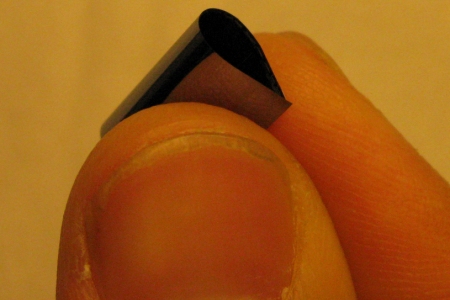The touchy-feely robot coming soon
Published: 1 May 2014
A robot capable of sensing whether a cup of tea is too hot to handle may soon be a reality - thanks to a £1.07 million funding grant from the Engineering and Physical Sciences Research Council to support the creation of ultra-flexible tactile skin for robotics and prosthetics.
Think of a world where a robot can not only carry a cup of tea to an elderly person, but can also sense whether it’s too hot to handle.
Currently, it’s not within our technological reach – but it may be soon, thanks to a £1.07 million funding grant from the Engineering and Physical Sciences Research Council to support the creation of ultra-flexible tactile skin for robotics and prosthetics.
The four-year funding under the EPSRC’s Fellowship for Growth programme has been won by Dr Ravinder Dahiya, who joined the University of Glasgow last year as a senior lecturer in electronic and nanoscale engineering. He is one of the leading academics from 10 UK universities to have been awarded a total of £13 million to maintain the UK’s research leadership in three areas – Advanced Materials, Robotic and Autonomous Systems, and Synthetic Biology.
To date, no robotics scientist has been able to create ultra-flexible tactile skin. Either the sensor has been too big or the electronics not sufficiently flexible.
Now, however, Dr Dahiya believes he is on the cusp of a breakthrough and that he has found a way of incorporating electronics and sensors on bendable silicon-based surfaces that will be 50 micrometers thick – thinner than the aluminium foil we use every day.
 He will be working in collaboration with Professor Duncan Gregory, Chair in Inorganic Materials in the School of Chemistry, on the creation of silicon based nanostructures such as nanowires which are printed on bendable substrates in a manner that will eventually lead to flexible electronic or tactile skin with distributed sensors and electronics.
He will be working in collaboration with Professor Duncan Gregory, Chair in Inorganic Materials in the School of Chemistry, on the creation of silicon based nanostructures such as nanowires which are printed on bendable substrates in a manner that will eventually lead to flexible electronic or tactile skin with distributed sensors and electronics.
By developing a printing technique for high-mobility materials such as silicon, he will obtain high-performance electronics at a low cost base. This research will also use the state-of-the-art nanofabrication tools in the James Watt Nanofabrication Centre at the University of Glasgow.
“Interfacing the multidisciplinary fields of robotics and nanotechnology, this research on ultra-flexible tactile skin will open up whole new areas within both robotics and nanotechnology. So far, robotics research has focused on using dexterous hands, but if the whole body of a robot is covered with skin, it will be able to carry out tasks like lifting an elderly person.
"In the nanotechnology field, it will be a new paradigm whereby nanoscale structures are used not for nanoscale electronics, but for macroscale bendable electronics system. This research will also provide a much-needed electronics engineering perspective to the field of flexible electronics,” said Dr Dahiya.
His research is aligned with wider work on flexible electronics – the creation of bendable pieces of technology that will replace the flat screen computer or tablet.
In future, says Dr Dahiya, mobile phones will be more like a wristband, providing far more information than currently, such as carrying out health monitoring.
“Today’s robots are without skin which means they can’t feel the way we feel. But they need to be able to interact the way we do,” he said.
“As our demographic changes over the next 15-20 years, robots will be needed to help the elderly. In such a scenario, robots should have skin so that they can feel like we do – whether the surface is hard or soft, or rough or smooth. They should be able to feel weight,” he added.
Dr Dahiya envisages creating a “tactile” skin that would allow a robot to carry out various tasks ranging from lifting an elderly person or patient out of bed to gauging the right amount of pressure needed to carry a fragile china cup of tea from the kitchen to an elderly person in another room. He also foresees uses in the creation of more touch-sensitive prosthetics.
He already has strong industry links with the London-based company Shadow Robotics and prosthetics specialist Touch Bionics, based in Livingston; both companies will work alongside the researchers to check the effectiveness of their work.
Find out more
Media Enquiries: Liz.Buie@glasgow.ac.uk/ 0141 330 2702; 07527 335373
Notes to Editors
Dr Ravinder Dahiya is a Senior Lecturer in the Electronics and Nanoscale Engineering Research Division at the University of Glasgow. His academic career to date includes a B.Tech (Electrical Engg.) from Kurukshetra University (India), an M.Tech. (Electrical Engg.) from the Indian Institute of Technology Delhi (India), and a Ph.D. from the Italian Institute of Technology, Genoa, and the University of Genoa (Italy). He has worked at the University of Delhi, the Italian Institute of Technology in Genoa, the Fondazione Bruno Kessler in Trento (Italy), and the University of Cambridge. He is also a senior member of the Institute of Electrical and Electronics Engineers.
His multidisciplinary research interests include tactile sensing, flexible electronics and sensors, electronic skin, microsystems and robotics. He serves on the editorial boards of IEEE Transactions on Robotics and the IEEE Sensors Journal. He is Guest Editor of IEEE Sensors Journal Special Issue on “Printable Sensors and Systems” (2014). He was Guest Editor of IEEE Sensors Journal Special Issue on “Flexible Sensors and Sensing Systems” (Oct 2013) and IEEE Transactions on Robotics Special Issue on “Robotic Sense of Touch” (June 2011). He represents the IEEE Robotics & Automation Society in the IEEE Sensors Council AdCom.
First published: 1 May 2014
<< May

